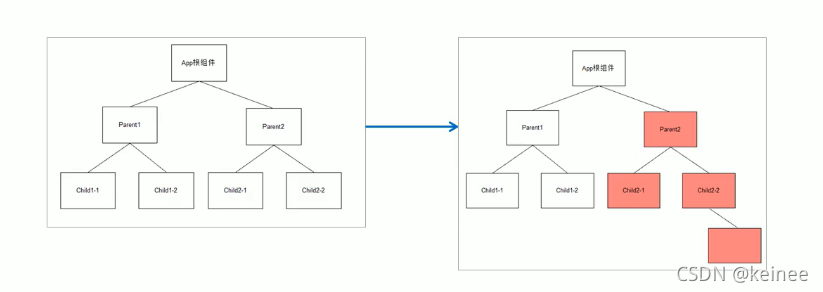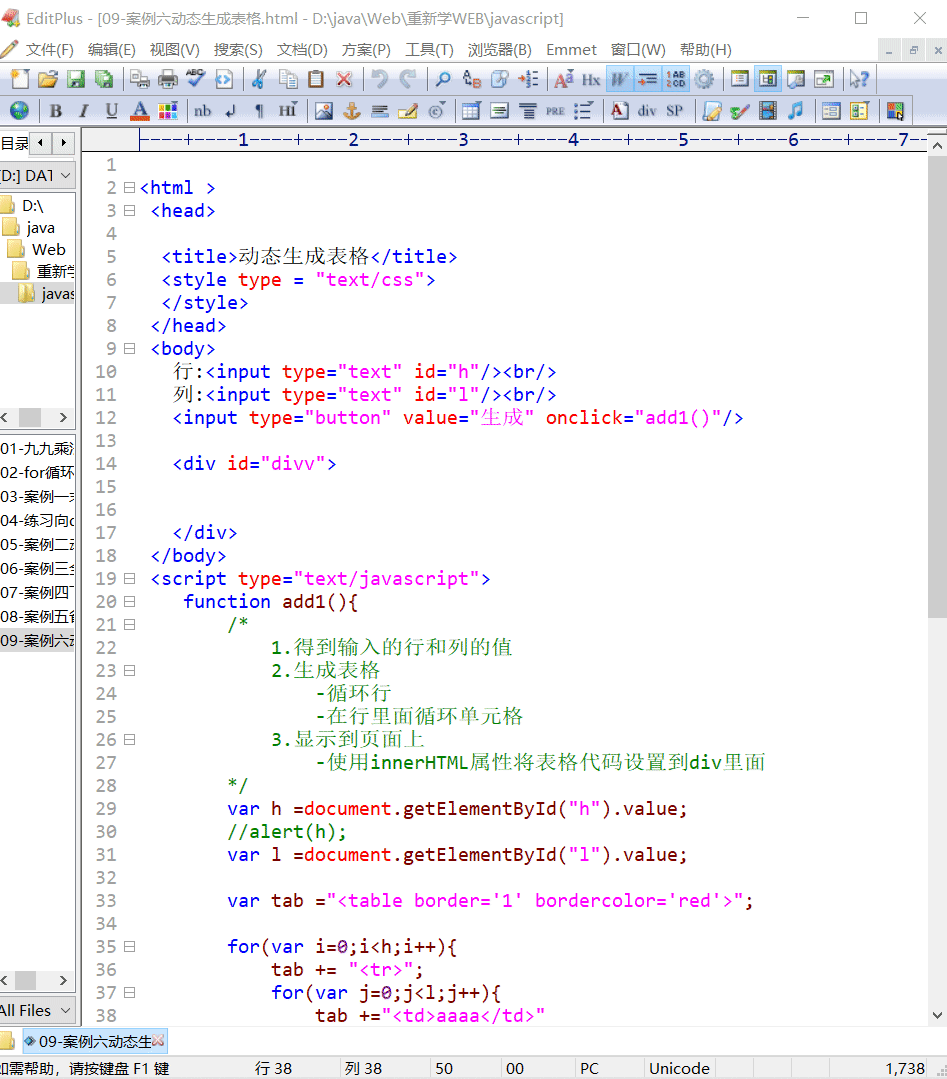目录
- 1.setState() 说明
- 1.1 更新数据
- 1.2 推荐语法
- 1.3 第二个参数
- 2.JSX 语法的转化过程
- 3.组件更新机制
- 4.组件性能优化
- 4.1 减轻 state
- 4.2 避免不必要的重新渲染
- 总结
1.setState() 说明
1.1 更新数据
setState() 是异步更新数据
可以多次调用 setState() ,只会触发一次重新渲染
import React from 'react'
import ReactDOM from 'react-dom'
class Opp extends React.Component {
state = {
count: 1,
}
handleClick = () => {
// 异步更新数据
this.setState({
count: this.state.count + 1,
})
this.setState({
count: this.state.count + 1,
})
console.log(this.state.count) // 1
}
render() {
return (
<div>
<h1>计数器:{this.state.count}</h1>
<button onClick={this.handleClick}>+1</button>
</div>
)
}
}
ReactDOM.render(<Opp />, document.getElementById('root'))
1.2 推荐语法
使用 setState((state,props)=>{}) 语法
state:表示最新的 state, props:表示最新的 props
import React from 'react'
import ReactDOM from 'react-dom'
class Opp extends React.Component {
state = {
count: 1,
}
handleClick = () => {
/* // 异步更新数据
this.setState({
count: this.state.count + 1,
})
console.log(this.state.count) //1
this.setState({
count: this.state.count + 1,
})
console.log(this.state.count) //1
*/
// 推荐语法
this.setState((state, props) => {
return {
count: state.count + 1,
}
})
this.setState((state, props) => {
console.log('第二次调用:', state) //2
return {
count: state.count + 1,
}
})
console.log(this.state.count) // 3
}
render() {
return (
<div>
<h1>计数器:{this.state.count}</h1>
<button onClick={this.handleClick}>+1</button>
</div>
)
}
}
ReactDOM.render(<Opp />, document.getElementById('root'))
1.3 第二个参数
- 在状态更新(页面完成重新渲染)后立即执行某个操作
- 语法:setState(updater[,callback])
callback 是指回调函数 可加可不加
import React from 'react'
import ReactDOM from 'react-dom'
class Opp extends React.Component {
state = {
count: 1,
}
handleClick = () => {
this.setState(
(state, props) => {
return {
count: state.count + 1,
}
},
// 状态更新后并且重新渲染后,立即执行
() => {
console.log('状态更新完成:', this.state.count) // 2
console.log(document.getElementById('title').innerText) // 计数器:2
document.title = '更新后的 count 为:' + this.state.count
}
)
console.log(this.state.count) //1
}
render() {
return (
<div>
<h1 id='title'>计数器:{this.state.count}</h1>
<button onClick={this.handleClick}>+1</button>
</div>
)
}
}
ReactDOM.render(<Opp />, document.getElementById('root'))
2.JSX 语法的转化过程
- JSX 仅仅是 createElement() 方法的语法糖(简化语法)
- JSX 语法被 @babel/preset-react 插件编译为 createElement() 方法
- React元素:是一个对象,用来描述你希望在屏幕上看到的内容

import React from 'react'
import ReactDOM from 'react-dom'
// JSX 语法的转化过程
// const element = <h1 className='greeting'>Hello JSX</h1>
const element = React.createElement(
'h1',
{
className: 'greeting',
},
'Hello JSX'
)
console.log(element)
ReactDOM.render(element, document.getElementById('root'))
3.组件更新机制
- setState() 的两个作用:1.修改 state 2.更新组件(UI)
- 过程:父组件重新渲染是,也会重新渲染子组件,但只会渲染当前组件子树(当前组件及其所有子组件)

4.组件性能优化
4.1 减轻 state
- 减轻 state :只存储跟组件渲染相关的数据(比如:count /列表数据/ loading 等)
- 注意:不用渲染的书籍不要放在 state 中(比如定时器 id 等)
- 需要在多个方法中用到的数据,应该放在 this 中
4.2 避免不必要的重新渲染
- 组件更新机制:父组件更新会引起子组件也被更新
- 问题:子组件没有变化时也会被重新渲染,造成不必要的重新渲染
- 解决方式:使用钩子函数shouldComponentUpdate(nextProps,nextState)
- 作用:通过返回值决定该组件是否重新渲染,返回 true 表示重新渲染, false 表示不重新渲染
- 触发时机:更新阶段的钩子函数,组件重新渲染前执行(shouldComponentUpdate -> render)
import React from 'react'
import ReactDOM from 'react-dom'
class Opp extends React.Component {
state = {
count: 0,
}
handleClick = () => {
this.setState((state) => {
return {
count: this.state.count + 1,
}
})
}
// 钩子函数
shouldComponentUpdate(nextProps, nextState) {
// 返回 false,阻止组件重新渲染
// return false
// 最新的状态
console.log('最新的state', nextState)
// 更新前的状态
console.log(this.state)
// 返回 true,组件重新渲染
return true
}
render() {
console.log('组件更新了')
return (
<div>
<h1>计数器:{this.state.count}</h1>
<button onClick={this.handleClick}>+1</button>
</div>
)
}
}
ReactDOM.render(<Opp />, document.getElementById('root'))
案例:随机数
通过 nextState
import React from 'react'
import ReactDOM from 'react-dom'
// 生成随机数
class Opp extends React.Component {
state = {
number: 0,
}
handleClick = () => {
this.setState((state) => {
return {
number: Math.floor(Math.random() * 3),
}
})
}
// 两次生成的随机数可能相同,则没必要重新渲染
shouldComponentUpdate(nextState) {
console.log('最新状态:', nextState, '当前状态:', this.state)
return nextState.number !== this.state.number
/* if ( nextState.number !== this.state.number) {
return true
}
return false*/
}
render() {
console.log('render')
return (
<div>
<h1>随机数:{this.state.number}</h1>
<button onClick={this.handleClick}>重新生成</button>
</div>
)
}
}
ReactDOM.render(<Opp />, document.getElementById('root'))
通过 nextState
import React from 'react'
import ReactDOM from 'react-dom'
// 生成随机数
class Opp extends React.Component {
state = {
number: 0,
}
handleClick = () => {
this.setState((state) => {
return {
number: Math.floor(Math.random() * 3),
}
})
}
render() {
return (
<div>
<NumberBox number={this.state.number} />
<button onClick={this.handleClick}>重新生成</button>
</div>
)
}
}
class NumberBox extends React.Component {
shouldComponentUpdate(nextProps) {
console.log('最新props:', nextProps, '当前props:', this.props)
return nextProps.number !== this.props.number
}
render() {
console.log('子组件render')
return <h1>随机数:{this.props.number}</h1>
}
}
ReactDOM.render(<Opp />, document.getElementById('root'))
总结
本篇文章就到这里了,希望能够给你带来帮助,也希望您能够多多关注NICE源码的更多内容!











